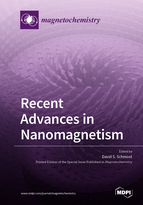Recent Advances in Nanomagnetism
A special issue of Magnetochemistry (ISSN 2312-7481). This special issue belongs to the section "Magnetic Nanospecies".
Deadline for manuscript submissions: closed (31 October 2021) | Viewed by 21845
Special Issue Editor
Interests: nanotechnologies; nanomagnetism; magnetic nanoparticles and nanostructures; magnetic thin films and multilayers; magnetization dynamics
Special Issues, Collections and Topics in MDPI journals
Special Issue Information
Dear Colleagues,
Nanomagnetism covers a broad range of research in magnetism and magnetic properties of low-dimensional systems, including both experimental methods in sample fabrication and characterization, as well as theoretical modeling and simulations. Size limitations in one, two, and three dimensions have led to a number of technologically important developments, having an extensive range of applications in sensors and activators, notably in the magnetic recording industry and spintronic devices and more recently in biomedical applications. Magnetic systems can have a variety of symmetries, from thin film geometries to wires and dots, as well as a number of nanoparticle structures, which can also have core–shell substructures. The magnetic state of nanometric magnetic structures results from the equilibrium between competing magnetic anisotropies, interactions, and the applied magnetic field. This can produce a number of phenomena, such as exchange bias effects, skyrmions, as well as magnetic instabilities, which can lead to superparamagnetic effects in magnetic nanoparticles and nanostructures. The physical dimensions and shape of a magnetic structure, as well as its intrinsic magnetic anisotropies, will determine whether it is a single domain or has a more complex magnetic domain structure. Traditionally patterned nanostructures have been planar arrays of nanomagnets, though recent trends have shown how this can be extended to three-dimensional structures where more complex magnetic configurations are possible and give rise to unprecedented magnetic properties.
Prof. David S. Schmool
Guest Editor
Manuscript Submission Information
Manuscripts should be submitted online at www.mdpi.com by registering and logging in to this website. Once you are registered, click here to go to the submission form. Manuscripts can be submitted until the deadline. All submissions that pass pre-check are peer-reviewed. Accepted papers will be published continuously in the journal (as soon as accepted) and will be listed together on the special issue website. Research articles, review articles as well as short communications are invited. For planned papers, a title and short abstract (about 100 words) can be sent to the Editorial Office for announcement on this website.
Submitted manuscripts should not have been published previously, nor be under consideration for publication elsewhere (except conference proceedings papers). All manuscripts are thoroughly refereed through a single-blind peer-review process. A guide for authors and other relevant information for submission of manuscripts is available on the Instructions for Authors page. Magnetochemistry is an international peer-reviewed open access monthly journal published by MDPI.
Please visit the Instructions for Authors page before submitting a manuscript. The Article Processing Charge (APC) for publication in this open access journal is 2700 CHF (Swiss Francs). Submitted papers should be well formatted and use good English. Authors may use MDPI's English editing service prior to publication or during author revisions.
Keywords
- Nanomagnetism
- Thin-films and magnetic multilayers
- Nanoparticles and core–shell structures
- Magnetic nanostructures
- Skyrmions
- Superparamagnetism
- Artificial spin–ice structures
- Spintronics
- Magnetization dynamics in nanostructures






